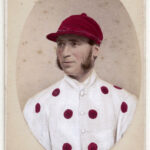30 January 1709: Charles Boswell, king of the gypsies, is buried at Rossington, Doncaster
Joseph Hunter. 1828. South Yorkshire, Vol. 1. London: Joseph Hunter. Get it:
.Excerpt
Near the chancel door was formerly a gravestone, protected by iron rails, covering the remains of Charles Boswell. This person is still remembered in the traditions of the village as having established a species of sovereignty among that singular people called the gypsies, who, before the enclosures, used to frequent the moors about Rossington. His word amongst them was law; and his authority so great that he perfectly restrained the pilfering propensities for which the tribe is censured, and gained the entire goodwill for himself and his people of the farmers and the people around. He was a gentleman with an estate of about £200 a year, and is described by De la Pryme of Hatfield as “a mad spark, mighty fine and brisk, and keeps company with a great many gentlemen knights, and esquires, yet runs about the country.” No member of this wandering race for many years passed near Rossington without going to pay respect to the grave of him whom they called their king; and I am informed that even now, if the question were asked of any of the people who still haunt the lanes in this neighbourhood, especially about the time of Doncaster races, they would answer that they were Boswell’s people.
Comment
Comment
Edward Miller:
It is remarkable that this is the first name mentioned in the present parish register… For a number of years it was a custom of the gipsies from the South to visit his tomb annually, and there perform some of their accustomed rites, one of which was to pour a flagon of ale upon the grave (Miller 1804).
But Miller thinks he’s James Bosvill, so maybe we don’t need to worry too much about the sexton’s reaction to notional ale-pouring.
WP:
James Boswell
Is buried in Rossington, near Doncaster in Yorkshire. Langdale’s “Topographical Dictionary of Yorkshire” (1822), says: “In the church yard, was a stone, the two ends of which are now remaining, where was interred the body of James Bosvill the King of the Gypsies, who died 30 January 1708. For a number of years, it was a custom of Gypsies from the south, to visit his tomb annually, and there perform some of their accustomed rites; one of which was to pour a flagon of ale upon the grave.” This is similar to the ritual of “stalling the rogue” mentioned by Thomas Harman and in The Beggars Bush and by Bampfylde Moore Carew.A tradition was reported of annual visits to the grave of Charles Boswell near Doncaster for more than 100 years into the 1820s, including a rite of pouring a flagon of hot ale into the tomb. This may be the same person.[6][7][8] The grave is situated by the main door leading to the church, shaded by a dark oak tree. It is now covered in moss, but is still readable. The words “King Of The Gypsies” will lie there for ever more, whereas the mystery of the black cat is still unsolved. – information on the grave by A. Needham – P. Needham, of St Michaels church.
Something to say? Get in touch
Original
Near the chancel door was formerly a gravestone, protected by iron rails, covering the remains of Charles Bosvile, whose interment is recorded in the parish register as having taken place on Sunday, the 30th of January, 1708-9. This person is still remembered in the traditions of the village as having established a species of sovereignty among that singular people called the gypsies, who, before the enclosures, used to frequent the moors about Rossington. His word amongst them was law; and his authority so great that he perfectly restrained the pilfering propensities for which the tribe is censured, and gained the entire goodwill for himself and his people of the farmers and the people around. He was a gentleman with an estate of about £200. a year, and is described by De la Pryme of Hatfield as “a mad spark, mighty fine and brisk, and keeps company with a great many gentlemen knights, and esquires, yet runs about the country.” He was a similar character to Bampfield Moore Carew, who, a little later, lived the same kind of wandering life. No member of this wandering race for many years passed near Rossington without going to pay respect to the grave of him whom they called their king; and I am informed that even now, if the question were asked of any of the people who still haunt the lanes in this neighbourhood, especially about the time of Doncaster races, they would answer that they were Bosvile’s people.
248 words.
Similar
 14 September 1864: In his last race, the St Leger Stakes (Doncaster), the legendary Blair Athol faces his great rival, General Peel, in monsoon conditions
14 September 1864: In his last race, the St Leger Stakes (Doncaster), the legendary Blair Athol faces his great rival, General Peel, in monsoon conditionsSearch
Donate
Music & books
Place-People-Play: Childcare (and the Kazookestra) on the Headingley/Weetwood borders next to Meanwood Park.
Music from and about Yorkshire by Leeds's Singing Organ-Grinder.



 Bluesky
Bluesky Extwitter
Extwitter